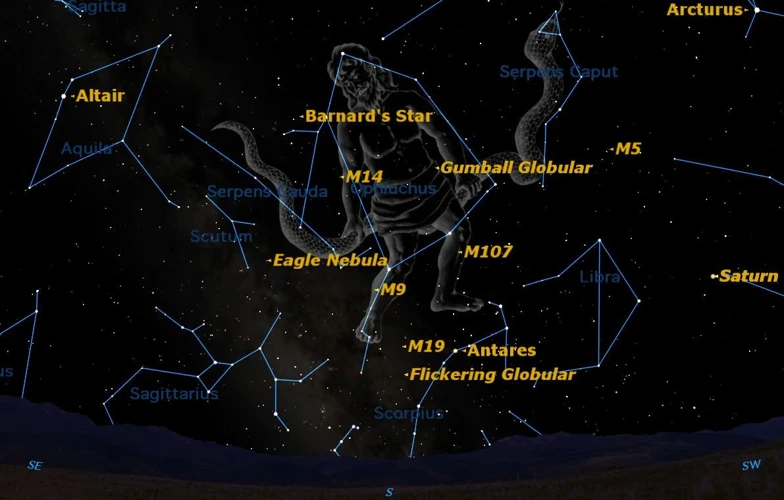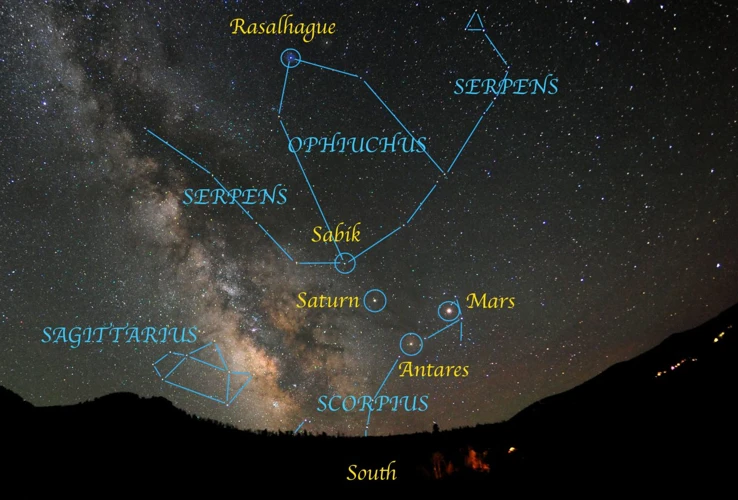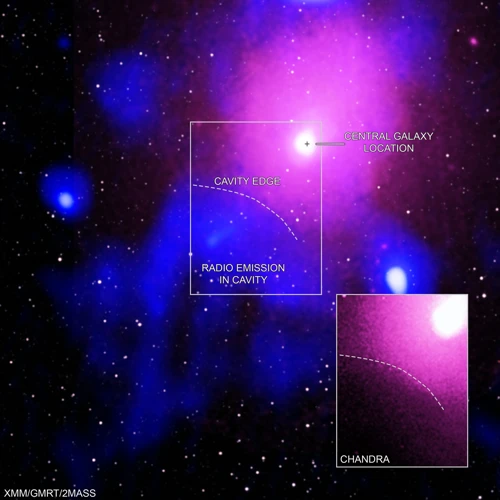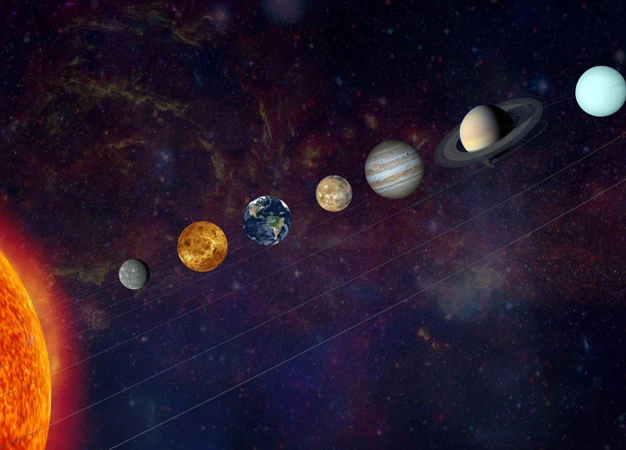Have you ever gazed up at the night sky, contemplating the mysteries of the universe? One of the most intriguing phenomena that captivates both scientists and stargazers alike is planetary alignments. The sheer beauty of celestial bodies aligning in perfect harmony is a sight to behold. But there is more to planetary alignments than meets the eye. In this article, we will delve into the fascinating science behind these cosmic occurrences. Join us on a journey as we explore the concept of planetary alignments, their influence on our solar system, their historical significance, scientific studies conducted, and their connection to astrology. Prepare to be amazed as we unravel the secrets of the mesmerizing dance of the planets.
Contents
- The Concept of Planetary Alignments
- The Influence of Planetary Alignments
- Historical Significance of Planetary Alignments
- Scientific Studies on Planetary Alignments
- The Connection to Astrology and Astrological Alignments
- Conclusion
-
Frequently Asked Questions
- 1. How often do planetary alignments occur?
- 2. Can planetary alignments cause major gravitational effects on Earth?
- 3. Are planetary alignments visible to the naked eye?
- 4. Do planetary alignments have any impact on astrology?
- 5. Can planetary alignments cause earthquakes or natural disasters?
- 6. Are there any upcoming notable planetary alignments to observe?
- 7. How do scientists study and track planetary alignments?
- 8. Can planetary alignments affect space missions or satellite operations?
- 9. What role do planetary alignments play in the search for exoplanets?
- 10. Are there any myths or legends associated with planetary alignments?
- References
-
Frequently Asked Questions
- FAQs about Planetary Alignments
- 1. What is a planetary alignment?
- 2. How often do planetary alignments occur?
- 3. Can planetary alignments have an impact on Earth?
- 4. Are all types of planetary alignments the same?
- 5. What are the gravitational effects of planetary alignments?
- 6. Did ancient civilizations believe in the significance of planetary alignments?
- 7. How do scientists study and analyze planetary alignments?
- 8. Is there any connection between planetary alignments and astrology?
- 9. Have any significant astronomical discoveries been made through studying planetary alignments?
- 10. Can planetary alignments predict future events or have any predictive powers?
- References
- Read More
The Concept of Planetary Alignments

A planetary alignment refers to the phenomenon when multiple celestial bodies, such as planets, moons, or asteroids, appear in a straight line or a close configuration in the sky when viewed from Earth. This alignment is due to the gravitational forces exerted by these celestial bodies as they orbit the Sun.
Planetary alignments are relatively rare events, occurring at specific intervals based on the orbital periods of the planets involved. The frequency of alignments varies depending on the specific planetary combination and their relative positions in their orbits. For example, the alignment of all the planets in our solar system is an exceptionally rare phenomenon that occurs only once every few centuries.
There are different types of planetary alignments, each characterized by the number and arrangement of the celestial bodies involved. Some common types include:
- Conjunctions: A conjunction occurs when two or more celestial bodies appear close together in the sky. This can happen between planets, planets and the Moon, or planets and stars.
- Oppositions: An opposition occurs when two celestial bodies are on directly opposite sides of the sky, as observed from Earth. This typically happens when Earth is located between the Sun and a planet.
- Grand Conjunctions: A grand conjunction, also known as a triple conjunction, refers to the alignment of three or more planets in a relatively small area of the sky.
These different types of alignments create visually stunning celestial displays and have been the subject of fascination for astronomers and astrology enthusiasts alike.
1. Definition of Planetary Alignment
A planetary alignment is defined as the positional arrangement of multiple celestial bodies in a straight line or in a close configuration when observed from Earth. It occurs when two or more planets, moons, or other celestial objects align in such a way that they appear to be in a linear or nearly linear arrangement in the sky. This alignment is a result of the gravitational interactions between these celestial bodies as they orbit around the Sun. Planetary alignments can be visually stunning and captivating, especially when multiple planets align with each other or with other celestial objects like stars or the Moon.
While planetary alignments have fascinated humans for centuries, it is important to note that they do not always have significant physical effects on Earth. The gravitational influences of distant planets on our planet are relatively minor compared to the gravitational force exerted by the Sun or the Moon. However, they do provide scientists and researchers with valuable opportunities to study celestial mechanics, explore the dynamics of the solar system, and deepen our understanding of the universe.
To learn more about the compatibility of zodiac modalities, you can read our article on exploring compatibility of zodiac modalities. If you’re interested in the origins and history of constellations, check out our article on the origins and history of constellations. For a comparison between asteroids and comets, you can read our article on asteroids vs. comets explained.
2. Occurrence and Frequency
The occurrence and frequency of planetary alignments are determined by the orbital motion of the celestial bodies involved. Each planet in our solar system follows a unique path around the Sun, resulting in different orbital periods. As a result, the planets align in various configurations at different intervals.
For example, the inner planets, such as Mercury and Venus, have shorter orbital periods compared to the outer planets like Jupiter and Saturn. This means that alignments involving the inner planets are more frequent, while alignments of the outer planets are rarer and occur over longer time spans.
The alignment of all the planets in our solar system, known as a grand or great conjunction, is an exceedingly rare event due to the vast differences in their orbital periods and the specific timing required for such an alignment to occur. The last great conjunction of all the planets took place in 2000 and won’t happen again until 2161.
However, other alignments, such as conjunctions and oppositions, occur more regularly. Conjunctions between two planets may happen several times within a single year, depending on their relative positions in their orbits.
It’s important to note that while planetary alignments have a sense of awe and wonder associated with them, they do not have any significant impact on Earth or human affairs. The alignments are purely celestial events driven by the gravitational forces between the celestial bodies in our solar system.
3. Types of Planetary Alignments
There are various types of planetary alignments that occur in our solar system, each with its own unique characteristics and configurations. Let’s explore three fascinating types of planetary alignments:
- Conjunctions: Conjunctions are perhaps the most common type of planetary alignment. They occur when two or more celestial bodies appear close together in the sky, creating an illusion of alignment. The alignment can involve planets, moons, or even planets and stars. Conjunctions are often visible to the naked eye and can create breathtaking scenes of celestial beauty. One notable example of a conjunction is the conjunction between Venus and Jupiter, which occurs periodically and is easily visible to observers on Earth.
- Oppositions: In an opposition, two celestial bodies are positioned on opposite sides of the sky, as observed from Earth. This type of planetary alignment occurs when Earth is located between the Sun and a planet, causing the planet to appear in direct opposition to the Sun. Oppositions are commonly observed with the outer planets, such as Mars, Jupiter, and Saturn. During an opposition, the planet is at its closest distance to Earth, making it an ideal time for astronomers to study and observe these planets in detail.
- Grand Conjunctions: Grand conjunctions, also known as triple conjunctions, involve the alignment of three or more planets in a relatively small area of the sky. These rare events occur when multiple planets come together in their orbits and appear visually close to each other. One of the most famous grand conjunctions in recent history is the alignment of Jupiter and Saturn, which occurred on December 21, 2020. This rare event, often referred to as the “Christmas Star” or the “Great Conjunction,” captured the attention of millions around the world.
These remarkable types of planetary alignments offer awe-inspiring celestial spectacles and provide astronomers with valuable opportunities to study the dynamics and interactions of celestial bodies within our solar system. Exploring the intricacies of these alignments enhances our understanding of the cosmos and deepens our appreciation for the wonders of the universe.
The Influence of Planetary Alignments

Planetary alignments have a profound influence on the gravitational forces within our solar system. When celestial bodies align, their combined gravitational pull can affect the orbits and trajectories of nearby objects. This gravitational interaction can cause slight perturbations in the orbits of planets, asteroids, and comets. These disturbances can lead to changes in their velocities, positions, and orbital paths over time.
One notable example of the gravitational effects of planetary alignments is the phenomenon known as a “resonance.” This occurs when the gravitational forces between multiple planets align in such a way that they reinforce each other’s influence. The resonance can result in long-term stability in the orbital configuration of the planets involved.
Planetary alignments also play a role in shaping the dynamics of the orbits of celestial bodies. When planets align, their gravitational forces can induce changes in the eccentricity (shape) of their orbits. These changes can, in turn, affect the overall stability of the solar system and impact the long-term evolution of the orbits.
Additionally, planetary alignments can influence phenomena such as orbital resonances and orbital resonant interactions. An orbital resonance occurs when two celestial bodies have orbital periods that are in a simple integer ratio, leading to periodic gravitational interactions between them. This resonance can significantly impact the dynamics of their orbits, causing periodic changes and creating complex patterns of motion.
Celestial mechanics, the branch of astronomy that studies the motions and interactions of celestial bodies, is greatly influenced by planetary alignments. These alignments provide astronomers with opportunities to study the gravitational interactions and dynamics of multiple celestial bodies simultaneously.
By observing and analyzing planetary alignments, scientists can gain insights into the fundamental principles of celestial mechanics, refine their understanding of planetary motion, and make predictions about future celestial events. The study of planetary alignments also aids in understanding the formation and evolution of planetary systems, as well as their interactions with other celestial objects such as asteroids and comets.
1. Gravitational Effects
The gravitational effects of planetary alignments play a significant role in shaping the dynamics of our solar system. The gravitational force between celestial bodies is responsible for maintaining their orbits and governing their interactions. When planets align, their combined gravitational pull can have several effects.
One of the primary effects is the perturbation of orbits. As planets align, their gravitational forces can exert a tug on each other, causing slight deviations in their orbital paths. This perturbation can lead to changes in the eccentricity and inclination of orbits, resulting in a temporary disruption in the normal motion of the planets.
Additionally, planetary alignments can cause resonance phenomena. When the orbital periods of two celestial bodies are related by a simple integer ratio, they are said to be in resonance. This resonance can have a profound effect on the stability and behavior of the orbits involved. For example, the resonant interaction between Jupiter and Saturn, known as the Great Conjunction, has a periodicity of approximately 20 years and affects the overall structure of the solar system.
Gravitational effects can also influence the distribution of asteroids and comets in our solar system. As planets align, their gravitational fields can deflect the trajectory of these smaller objects, potentially leading to their ejection from the solar system or their migration into different regions.
All in all, the gravitational effects of planetary alignments illustrate the intricate interplay of celestial bodies and highlight the complex dynamics of our solar system.
2. Orbital Dynamics
The orbital dynamics of planetary alignments play a significant role in shaping the configurations we observe. Each celestial body in our solar system follows a unique orbit around the Sun, governed by the laws of gravity. These orbits are not perfectly circular but rather elliptical in shape, with the Sun at one of the foci of the ellipse.
When planets align, it is a result of their varying orbital speeds and distances from the Sun. As planets move in their respective orbits, their relative positions change over time. Occasionally, these positions align in such a way that they appear close together from our vantage point on Earth.
The orbital dynamics of planetary alignments can be explained using Kepler’s laws of planetary motion. These laws describe the relationship between a planet’s distance from the Sun, its orbital period, and the shape of its orbit. For example, the law of equal areas states that a line connecting a planet to the Sun sweeps out equal areas in equal times, meaning the closer a planet is to the Sun, the faster it moves in its orbit.
As a result of orbital dynamics, planetary alignments can be predictable to some extent. Astronomers can calculate and predict when certain alignments will occur based on the known orbital parameters of the celestial bodies involved. These predictions can help researchers plan observations and gather data during these rare events.
Understanding the orbital dynamics of planetary alignments allows us to appreciate the intricate celestial dance happening in our solar system. It is a testament to the precision and beauty of the laws that govern our universe.
3. Celestial Mechanics
Celestial mechanics is a branch of astronomy that focuses on studying the motion and behavior of celestial bodies, including planets, moons, comets, and asteroids. Understanding the celestial mechanics behind planetary alignments is crucial to unraveling the intricacies of these cosmic phenomena.
Kepler’s Laws of Planetary Motion: One of the foundational principles in celestial mechanics is Johannes Kepler’s three laws of planetary motion. These laws describe the elliptical orbits of planets around the Sun and provide insights into how planets interact with each other during alignments.
- Kepler’s First Law: Also known as the law of elliptical orbits, it states that planets move around the Sun in elliptical paths, with the Sun at one of the two foci of the ellipse.
- Kepler’s Second Law: Commonly referred to as the law of equal areas, it states that a line joining a planet to the Sun sweeps out equal areas in equal intervals of time. This indicates that a planet moves faster when it is closer to the Sun and slower when it is farther away.
- Kepler’s Third Law: Known as the law of harmonies, it relates the orbital period of a planet to its average distance from the Sun. It mathematically demonstrates that the square of a planet’s orbital period is directly proportional to the cube of its average distance from the Sun.
These laws provide a mathematical framework for understanding the motion of planets and help astronomers predict celestial events, including planetary alignments.
Gravitational Interactions: Planetary alignments occur due to the gravitational interactions among celestial bodies. The gravitational force exerted by each planet affects the orbits and movements of other nearby planets.
- Perturbations: During a planetary alignment, the gravitational influence of one planet on another can cause perturbations in their orbits. These perturbations can lead to slight deviations from their regular paths.
- Resonances: In certain alignments, planets may end up in resonant configurations, where their orbital periods have a simple ratio to one another (e.g., 2:1 or 3:2). These resonances can have a stabilizing effect on their orbits over long periods of time.
Understanding the celestial mechanics involved in planetary alignments allows scientists to explore the intricate dynamics of our solar system and sheds light on the fascinating interactions between celestial bodies.
Historical Significance of Planetary Alignments

Planetary alignments have held significant importance throughout human history, influencing the beliefs, interpretations, and discoveries of various cultures and civilizations.
1. Ancient Beliefs and Myths: Many ancient civilizations, such as the Mayans, Egyptians, and Greeks, attributed great significance to planetary alignments. They believed that these alignments were interconnected with the gods and held mystical powers. For example, the alignment of certain planets was thought to symbolize the birth or rise of a powerful ruler, while others were associated with cosmic events and natural disasters.
2. Cultural Interpretations: Planetary alignments have also played a role in shaping religious and cultural practices. In ancient astrology, the alignment of planets was believed to influence human behavior, character traits, and even determine one’s destiny. Various cultures developed intricate systems to interpret and predict the effects of planetary alignments on individuals and society as a whole.
3. Astronomical Discoveries: Throughout history, planetary alignments have provided opportunities for astronomers to make important discoveries and advancements in their understanding of the universe. For example, the alignment of Venus and the Sun allowed astronomers to measure the distance between Earth and the Sun, known as the Astronomical Unit. Additionally, the discovery of Uranus in 1781 was made possible due to its alignment with Jupiter and the Sun.
The historical significance of planetary alignments showcases how they have shaped human beliefs, cultural practices, and scientific progress. Exploring the historical context allows us to appreciate the lasting impact that these celestial events have had on our understanding of the world and our place in the universe.
1. Ancient Beliefs and Myths
In ancient times, planetary alignments held immense significance in various cultures and gave rise to a wealth of beliefs and myths. Ancient civilizations, such as the Egyptians, Greeks, and Mayans, attributed great spiritual and astrological significance to these celestial events. For example, in Egyptian mythology, the alignment of certain planets was associated with specific deities or cosmic events. The ancient Greeks believed that planetary alignments were auspicious and could either bring blessings or foretell doom. The Mayans, known for their advanced astronomical knowledge, believed that planetary alignments had a profound influence on the fate of the world. These cultural interpretations of planetary alignments highlight the deep-seated fascination and reverence that ancient civilizations held for these celestial phenomena. The myths and beliefs associated with planetary alignments not only shaped their religious and spiritual practices but also influenced their calendars, astrology systems, and even architectural designs. To this day, the historical significance of planetary alignments continues to captivate and intrigue us, offering a glimpse into the ancient minds that observed and revered the celestial wonders above.
2. Cultural Interpretations
Cultural interpretations of planetary alignments vary across different civilizations and time periods. Throughout history, many cultures have assigned symbolic meanings and significance to the alignment of celestial bodies. In ancient times, planetary alignments were often associated with religious or spiritual beliefs. For example, the ancient Egyptians believed that the alignment of certain planets, such as Venus and Sirius, signaled the arrival of a new king or the beginning of a new era. Similarly, in Mesopotamian culture, the alignment of planets was seen as an omen or a celestial message from the gods. These cultural interpretations highlight the deep connection between celestial events and the human desire to find meaning in the cosmos. In more recent times, planetary alignments have also influenced popular culture and art. For instance, planetary alignments have been depicted in literature, music, and even movies, capturing the imagination of people and inspiring creative expressions. The cultural interpretations of planetary alignments reflect the universal fascination with the night sky and its impact on human history and artistic expression.
3. Astronomical Discoveries
Astronomical discoveries related to planetary alignments have played a significant role in advancing our understanding of the universe. The study of planetary alignments has allowed scientists to make groundbreaking observations and uncover important information about our solar system and beyond.
One notable astronomical discovery linked to planetary alignments is the detection of exoplanets. By carefully observing the subtle changes in the light from distant stars during planetary alignments, scientists have been able to identify and study planets located outside our solar system. This has revolutionized our understanding of planetary systems and their formation.
Planetary alignments have provided valuable opportunities for studying celestial bodies that are otherwise difficult to observe. For example, when a planet aligns with a distant star, researchers can use a process called gravitational microlensing to study the properties of the star, including its mass and composition. This technique has allowed scientists to explore remote regions of the Milky Way and discover previously unknown objects, such as brown dwarfs and rogue planets.
Additionally, planetary alignments have played a crucial role in the discovery and study of celestial objects within our own solar system. For instance, the alignment of planets with asteroids has provided opportunities for researchers to study these rocky bodies more closely. By analyzing the effects of planetary gravitational forces on the motion of asteroids during alignments, scientists have gained insights into their composition, structure, and origin.
The ability to make these astronomical discoveries through the study of planetary alignments has opened new avenues for research and exploration. It allows scientists to gather data that contributes to our knowledge of the cosmos and expands our understanding of the vast universe we inhabit. Through continued advancements in technology and ongoing research, there is no doubt that even more exciting astronomical discoveries await in the future.
Scientific Studies on Planetary Alignments

Scientific studies on planetary alignments have utilized various research methodologies to investigate and understand the phenomenon. Astronomers and astrophysicists employ advanced telescopes, such as space-based observatories like the Hubble Space Telescope, to observe and analyze the alignment of celestial bodies with precision. They also use computer simulations and modeling techniques to recreate and study past and future alignments.
In addition to direct observations, researchers often gather data through spectroscopy, which involves analyzing the light emitted or absorbed by celestial bodies. This data provides valuable information about the composition, temperature, and other physical properties of the aligned objects.
Through scientific studies on planetary alignments, researchers have made several significant findings. They have discovered that planetary alignments can have notable gravitational effects on each other, affecting their orbits and influencing the stability of the entire solar system.
Researchers have also observed that planetary alignments can serve as opportunities to study celestial bodies in greater detail. During certain alignments, scientists can measure gravitational microlensing, a phenomenon where the light from a distant object is bent as it passes near a massive planet in alignment with the line of sight. This allows scientists to study distant objects that would otherwise be difficult to observe.
Studies have shown that planetary alignments are not confined to our solar system alone. Astronomers have observed exoplanetary systems with multiple planets aligning in their orbits, providing valuable insights into the formation and evolution of planetary systems beyond our own.
Through continued research and scientific advancements, our understanding of planetary alignments and their significance in the broader context of the universe continues to expand.
1. Research Methodologies
When studying planetary alignments, scientists employ various research methodologies to analyze and understand these unique astronomical events. Here are some key research methodologies used in the study of planetary alignments:
- Astronomical Observations: Astronomers use telescopes and other observation tools to track the positions and movements of celestial bodies. By observing the alignment of planets and other celestial objects, researchers can gather data and study the patterns and dynamics of these alignments.
- Numerical Simulations: Computer simulations play a crucial role in understanding planetary alignments. Scientists use complex algorithms and mathematical models to simulate the gravitational interactions and orbital mechanics of celestial bodies. These simulations help researchers gain insights into the formation and behavior of planetary alignments and predict future occurrences.
- Data Analysis: After collecting observations and simulation results, scientists analyze the data to identify patterns, correlations, and anomalies. This involves statistical analysis, data visualization, and comparison with existing theories to validate or refine our understanding of planetary alignments.
- Astrophysical Modeling: Researchers develop astrophysical models to explain the physical processes and mechanisms behind planetary alignments. These models take into account factors such as gravitational forces, orbital dynamics, and the influence of other celestial bodies. By simulating different scenarios, scientists can investigate the factors that contribute to specific types of alignments.
- Collaborative Studies: Scientists often collaborate with colleagues and participate in international research efforts to study planetary alignments. Sharing data, expertise, and resources allows for a broader understanding and more comprehensive analysis of these celestial events.
By employing these research methodologies, scientists can unlock the mysteries surrounding planetary alignments and gain insights into the intricate workings of our solar system. These studies contribute to our understanding of celestial mechanics, gravitational forces, and the overall dynamics of the universe.
2. Data Analysis and Findings
Data analysis plays a crucial role in studying planetary alignments and understanding their patterns and effects. Scientists gather observational data of planetary positions and movements over extended periods. This data is then analyzed using various mathematical models and computer simulations to study the intricate dynamics of planetary alignments.
Through data analysis, researchers have made several fascinating findings. One significant finding is that planetary alignments have a measurable influence on the gravitational forces within our solar system. These alignments can cause gravitational interactions, affecting the orbits and trajectories of celestial bodies. Data analysis has revealed that planetary alignments can lead to resonance phenomena, where the gravitational forces between planets synchronize their orbital periods.
Additionally, data analysis has been instrumental in identifying potential correlations between planetary alignments and geological events on Earth. Some studies have suggested a possible link between specific alignments and phenomena such as earthquakes and volcanic activities. These findings have opened up new avenues for further research into understanding the intricate relationships between celestial events and earthly occurrences.
Data analysis also allows scientists to predict future planetary alignments accurately. By analyzing the orbital parameters and positions of planets, they can calculate when specific alignments will occur and the frequency at which they are likely to happen. This information is invaluable for astronomers and enthusiasts, as they can plan observations and astronomical events around these alignments.
Data analysis has provided valuable insights into the dynamics and significance of planetary alignments. It has revealed the measurable gravitational effects and resonance phenomena resulting from these alignments. It has helped establish potential correlations between planetary alignments and earthly phenomena. Through continued data analysis and research, we can gain a deeper understanding of the science behind planetary alignments and their impact on our solar system and beyond.
The Connection to Astrology and Astrological Alignments

Astrology and astronomy are closely intertwined, both exploring the relationships between celestial bodies and their influence on human life. Astrology, however, takes a more metaphysical approach, examining how planetary alignments and positions at the time of a person’s birth can impact their personality traits, behaviors, and even their future.
Astrological alignments are thought to carry symbolic meanings and represent certain energies or influences. For example, the alignment of the Sun, Moon, and planets in specific zodiac signs during a person’s birth is believed to shape their astrological sign and personality traits.
Astrologers interpret planetary alignments based on their positions in the zodiac, the aspects (angular relationships) they form with each other, and other astrological factors. For instance, a conjunction between two planets may be seen as a harmonious merging of their characteristics, while a square aspect may indicate tension or challenges.
While astrology and astronomy share some similarities, it’s essential to note that they are distinct disciplines. Astronomy is a scientific study focused on the observation and understanding of celestial objects and their physical properties. It follows the principles of physics and mathematics to explain the movement and behavior of planets and other astronomical bodies.
Despite the scientific skepticism surrounding astrology, many people find comfort and guidance in the astrological interpretations of planetary alignments. Astrology offers insight into personal traits and can provide a sense of connection to the cosmos. Whether you view astrology as a form of entertainment or a guiding force in your life, the intriguing connection between astrology and planetary alignments continues to captivate and inspire.
1. Astrology vs. Astronomy
When discussing planetary alignments, it is important to distinguish between astrology and astronomy, two disciplines often intertwined but with distinct differences.
Astronomy is the scientific study of celestial objects, their properties, and the physical laws that govern them. Astronomers use observations, mathematics, and physics to understand the universe and to make predictions about celestial events. It is a branch of science that is grounded in empirical evidence and objective analysis. Astronomers study planetary alignments to gain insights into the movements and interactions of celestial bodies, contributing to our understanding of the cosmos.
Astrology, on the other hand, is a belief system that posits a connection between the positions of celestial objects, such as planets and stars, and human experiences and personality traits. Astrologers interpret planetary alignments to make predictions about individual lives, relationships, and events. While astrology has historical and cultural significance, it is not considered a science and is not supported by empirical evidence or the scientific method.
It is crucial to differentiate between the two, as confusing astronomy with astrology can lead to misconceptions and misunderstandings. While astronomy provides a scientific understanding of planetary alignments, astrology offers a more subjective and interpretive approach.
2. Astrological Interpretations of Planetary Alignments
Astrology, a pseudoscience, interprets the significance of planetary alignments from a different perspective. In astrology, planetary alignments are believed to have a profound influence on individual personalities and worldly events based on the principles of astrological signs and horoscopes. According to astrologers, the positions of the planets at the time of a person’s birth can determine their character traits, behaviors, and destiny. Each planet is associated with specific qualities and energies, and when they align in certain configurations, it is believed to amplify or modify these influences. For example, the alignment of Mars and Venus is often associated with passion and love, while the alignment of Saturn and Pluto signifies transformation and challenges. Astrologers study and interpret planetary alignments to provide insights into relationships, career paths, and personal growth. It’s important to note that while astrological interpretations of planetary alignments may be popular, they lack scientific evidence and are not recognized by the scientific community.
Conclusion

In conclusion, the concept of planetary alignments is a captivating field of study that combines both scientific exploration and human fascination with the cosmos. The occurrence and frequency of planetary alignments, along with their various types, highlight the intricate dance of celestial bodies in our solar system. These alignments have significant effects on gravitational forces, orbital dynamics, and celestial mechanics, shaping the workings of our universe.
Throughout history, planetary alignments have held immense cultural significance, inspiring ancient beliefs, myths, and even leading to astronomical discoveries. Scientific studies have allowed researchers to investigate and analyze these alignments with advanced methodologies and data analysis techniques, unraveling the mysteries surrounding their occurrence.
Lastly, the connection between planetary alignments and astrology brings an additional layer of interpretation and meaning to these celestial events. While astronomy focuses on the scientific aspects of planetary alignments, astrology offers a different perspective on their influence, correlating them with astrological interpretations and characteristics.
As we continue to explore the fascinating science behind planetary alignments, we gain a deeper understanding of the intricate workings of our vast universe. The mesmerizing beauty and complexity of these cosmic events serve as a constant reminder of humanity’s never-ending curiosity about the mysteries of the cosmos.
Frequently Asked Questions

1. How often do planetary alignments occur?
The frequency of planetary alignments varies based on the specific combination of celestial bodies. Some alignments, like the alignment of all the planets in our solar system, occur once every few centuries. Others, such as conjunctions between planets, can happen more frequently.
2. Can planetary alignments cause major gravitational effects on Earth?
While planetary alignments can create gravitational interactions between celestial bodies, the effects on Earth are generally minor. The gravitational influence of individual planets on Earth is much smaller compared to the gravitational pull of the Sun and Moon.
3. Are planetary alignments visible to the naked eye?
Yes, many planetary alignments are visible to the naked eye. However, the visibility depends on factors such as the position of the alignment in the sky, time of day, and atmospheric conditions. Using a telescope can enhance the visibility and allow for a more detailed view.
4. Do planetary alignments have any impact on astrology?
According to astrologers, planetary alignments can have symbolic meanings and influence astrological interpretations. Astrologers believe that the alignment of celestial bodies at the time of a person’s birth can impact their personality traits and life events.
5. Can planetary alignments cause earthquakes or natural disasters?
While there have been speculations about potential correlations between planetary alignments and natural disasters, scientific studies have not found any conclusive evidence to support such claims. Earthquakes and natural disasters are primarily influenced by geological processes and interactions within Earth’s systems.
6. Are there any upcoming notable planetary alignments to observe?
There are several notable planetary alignments that astronomy enthusiasts can look forward to observing. For example, the alignment of Jupiter and Saturn, known as the Great Conjunction, occurred in 2020 and won’t happen again until 2040.
7. How do scientists study and track planetary alignments?
Scientists study and track planetary alignments using advanced telescopes and astronomical software. They calculate the positions and movements of celestial bodies based on their known orbits and use this information to predict and observe alignments.
8. Can planetary alignments affect space missions or satellite operations?
Planetary alignments can have some minor effects on space missions and satellite operations. For example, they may cause slight perturbations in satellite orbits, but these effects can be accounted for and managed by mission controllers and satellite operators.
9. What role do planetary alignments play in the search for exoplanets?
Planetary alignments can be used by astronomers to detect and study exoplanets. By observing how a planet transits in front of its star during an alignment, scientists can gather data on the exoplanet’s size, orbit, and atmosphere.
10. Are there any myths or legends associated with planetary alignments?
Throughout history, various cultures have associated myths and legends with planetary alignments. For example, ancient civilizations believed that alignments held mystical powers and could signify significant events or prophecies.
References
Frequently Asked Questions

FAQs about Planetary Alignments
Here are some frequently asked questions about planetary alignments and their intriguing science:
1. What is a planetary alignment?
A planetary alignment refers to the arrangement of multiple celestial bodies, such as planets or moons, in a straight line or a nearly straight line in the sky.
2. How often do planetary alignments occur?
Planetary alignments occur relatively rarely and depend on the specific configuration of planets in our solar system. Some alignments occur once in several years, while others may not happen for centuries.
3. Can planetary alignments have an impact on Earth?
While planetary alignments can create gravitational effects, their direct impact on Earth is negligible. The gravitational forces exerted by planets during alignments are significantly weaker than those of the Moon or the Sun.
4. Are all types of planetary alignments the same?
No, there are different types of planetary alignments. Some alignments involve multiple planets lining up with the Sun, whereas others occur when planets align with the Moon or with each other.
5. What are the gravitational effects of planetary alignments?
The gravitational effects of planetary alignments are primarily seen on the orbits of celestial bodies. They can cause slight perturbations in the orbits of planets, but these effects are generally small and have limited consequences.
6. Did ancient civilizations believe in the significance of planetary alignments?
Ancient civilizations, such as the Mayans and the Egyptians, attributed spiritual and symbolic meanings to planetary alignments. They believed that planetary alignments influenced various aspects of life on Earth, including agriculture and human behavior.
7. How do scientists study and analyze planetary alignments?
Scientists study planetary alignments using advanced astronomical observations and mathematical models. They collect data on the positions and movements of celestial bodies and analyze them to understand the patterns and dynamics of planetary alignments.
8. Is there any connection between planetary alignments and astrology?
Although astrology often mentions planetary alignments, it is considered a pseudoscience and is not based on scientific evidence. Astrologers interpret planetary alignments in terms of astrological signs and horoscopes, but these interpretations lack empirical support.
9. Have any significant astronomical discoveries been made through studying planetary alignments?
Studying planetary alignments has contributed to several significant astronomical discoveries. For example, advancements in understanding the gravitational effects of planetary alignments have helped scientists discover exoplanets in distant star systems.
10. Can planetary alignments predict future events or have any predictive powers?
No, planetary alignments cannot predict future events or have any predictive powers. The movements and alignments of celestial bodies are governed by the laws of physics and do not possess any inherent ability to foretell specific events on Earth.







